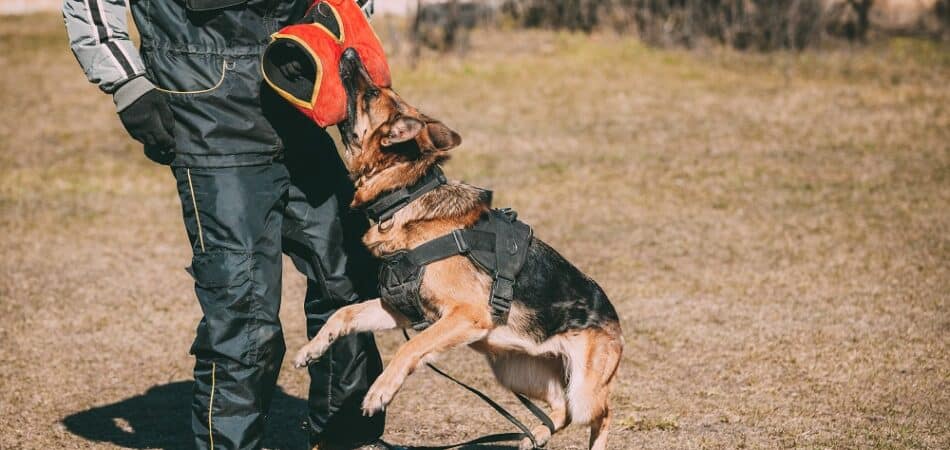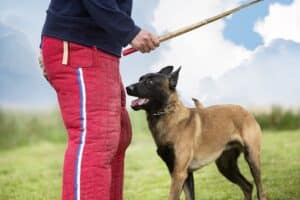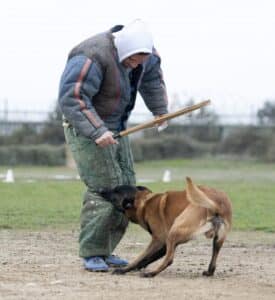






A bite sleeve is a great starting po
The protection dog training market is packed with everything from basic bite sleeves to high-tech training aids.
Marketing hype is everywhere promising miracle results, and social media has people convinced they need every tool under the sun—whether it actually works in the real world or not.
As someone who’s spent decades in this field, I can tell you that much of what’s being sold is unnecessary at best and dangerous at worst.
I mean, have you seen the influx of dogs that were started on some equipment like e-collars? Their owners come to Vanguard Protection Dogs for a variety of reasons.
Some of their dogs were fine off-leash but became leash-reactive. Others were so overexposed to e-collars that they stopped responding altogether, turning their obedience into a dumpster fire.
And then there are the anxious wrecks—dogs that fear corrections because the tools were used too soon or incorrectly.
Let me be clear: I’m not anti-training equipment. I use them, I recommend them. But the key is knowing when to introduce them.
Jumping straight into tools because your favorite influencer uses them? Bad idea.
Keep reading for our ultimate guide to essential equipment for protection dog training—so you get exactly what you need (and skip the stuff that just collects dust).
I’ll break down exactly what you need, when to use it, and—most importantly—why you need it.
Before we get into the specifics, let’s set the record straight. Training a protection dog is about clear communication, consistency, and respect.
Of course, the right tools help, but they don’t replace proper technique.
Now, here’s the gear you need.
Let’s start with the essentials—leashes, collars, muzzles, and harnesses
You need a solid 6-foot leather leash—not those flimsy nylon ones that fray the first time your dog pulls. Go for a 3/4-inch width—it’s strong, comfortable in your hand, and durable enough to handle real pressure.
Yes, it’s more expensive. Yes, it needs more care. But it also won’t burn your hands during control work, and that matters more than you think.
Other must-haves:
And always—have a backup for each. Trust me, you’ll thank yourself later.
For collars, you want two types when starting out: a flat buckle collar for everyday use and a martingale for training sessions. The martingale gives you better control without the risks associated with choke chains.
For more advanced training:
Controversial? Sure. But when used correctly, they mimic natural canine corrections and distribute pressure more evenly than choke or flat collars.
The prongs are angled inward with blunt tips, meaning they don’t jab or injure the dog—they simply create a sensation that requires far less force than other collars.
Unlike choke chains, prong collars have a built-in limit on how much they can tighten, reducing the risk of overcorrection.
I’ve never seen a dog injured from proper prong collar use. For dogs with sensitive skin, you can use rubber tips or a bandana as a buffer.
Different trainers have different fitting preferences, but I size the collar appropriately and place it mid-neck—loose enough that the dog doesn’t feel constant pressure but not so loose that it flips over.
For optimal leash communication, I always position the prongs on the back of the neck, never at the base. This placement ensures the dog only feels pressure when needed, avoiding unnecessary irritation that could lead to behavioral issues.
Modern e-collars don’t deliver painful shocks—instead, they use low-level stimulation, similar to a TENS unit, to get the dog’s attention. The goal isn’t to punish but to reinforce commands at a distance with precise, consistent cues.
I recommend using an e-collar only after your dog fully understands basic commands. The key is proper conditioning—starting at the lowest setting and pairing it with known cues so the dog perceives it as guidance, not correction.
Most dogs respond to a light tap, while others may need slight adjustments based on their sensitivity. Done right, an e-collar offers off-leash freedom without sacrificing control.
Buy from a reputable manufacturer—cheap knockoffs fail when you need them most. And please, skip the designer collars with rhinestones and bling. You’re training a protection dog, not accessorizing for Instagram.
During high-drive training, a muzzle prevents accidental nips and allows you to work safely. It keeps the handler and the dog focused, reducing the risk of redirected bites in moments of intense excitement or injuries.
Whether you’re working on obedience under pressure, or integrating a new training partner, a properly fitted muzzle adds a layer of security without interfering with performance.
No matter which muzzle type you choose, proper fit is critical. Muzzles are sized by snout length (typically measuring from ½” under the eyes to ½” past the nose) and width around the widest part of the mouth, with extra room for panting.
For dogs with a bite risk, I always choose a muzzle that fully prevents biting—some models don’t. It should have strong, secure straps, ideally with attachments that connect to a collar to prevent accidental removal.
Proper ventilation is also crucial, allowing the dog to breathe easily and pant freely, especially during prolonged wear or physical activity.
Look for:
Yes, your dog will pull in a harness. Mind blown, right? That’s exactly what they’re designed for. Unlike collars, which apply pressure to the neck, harnesses distribute force across the chest and shoulders—giving your dog more power, not less.
A well-fitted harness is essential for:
✔️ Resistance drills
✔️ Controlled agitation work
✔️ Structured tracking exercises
It reduces strain on the neck while keeping movement natural and control in your hands. Essential for serious training.
Top Picks for Protection Work:
Get the right harness, fit it properly, and use it for training—not as a crutch.
I guess you’ve seen a dog bite a sleeve before. Maybe you’ve even watched bite training in action—dogs launching at full speed, clamping down with precision, and holding firm.
The thing is, bite work is about control, targeting, and technique. The right equipment makes all the difference, ensuring safety while developing a powerful, confident bite.
The right sleeve depends on the dog’s experience level:

Before a dog moves onto sleeves, they must understand targeting and grip strength.
Hidden sleeves separate the sports dogs from the real deal. Unlike traditional bite sleeves, these are worn under regular clothing, forcing the dog to engage without visual cues.
If your dog hesitates or refuses to bite just because they don’t see the gear, they’re still in the early stages of training—and nowhere near ready for real-world protection work.
The goal? Bite on intent, not equipment. A properly trained dog should recognize a threat based on behavior (body language, energy), not whether someone’s wearing a bulky sleeve.
This is where scenario-based training comes in. Working with a skilled decoy in plain clothes—using controlled but realistic aggression—helps bridge the gap between training and actual protection.
It may seem like tug work is about having fun but there’s more to it— developing grip strength, engagement, and drive. Tugs reinforce bite commitment, improve targeting, and build confidence in young dogs.
But not all tugs are created equal. Choosing the right material and size depends on your dog’s training level and bite intensity.
Pro-tip: Always maintain control—never let the dog “win” by snatching the tug and running off. Structured play reinforces training, strengthens your bond, and ensures the dog sees the tug as a reward, not a free-for-all.
These tools make communication clearer, learning faster, and results more consistent.

Both methods rely on positive reinforcement—typically using treats, toys, or praise as a reward—making training more engaging, effective, and frustration-free.
Why It Works
Every time you use marker training, you’re telling your dog one of three things:
🐾Yes! – The moment they get it right, they hear the marker (a click or verbal cue). This pinpoints the exact behavior you want to reinforce.
🐾Keep going! – The marker is motivating, encouraging your dog to continue what they’re doing.
🐾Try again. – No marker? No reward. The dog quickly learns they need to adjust—without punishment, pressure, or confusion.
This system keeps dogs engaged, motivated, and eager to work. And it gets even better.
Clickers and markers work on every dog, from 8-week-old puppies learning the basics to 8-year-old dominant dogs that need retraining.
They’re also game-changers for aggressive, fearful, or stubborn dogs because the system is non-confrontational and crystal clear.
Place boards (raised platforms) are one of the most underrated training tools in the game. They create clear spatial boundaries, teaching dogs to stay put, hold positions under distraction, and refine obedience commands with pinpoint accuracy.
Trainers use place boards for everything from sharpening obedience to prepping dogs for competition and protection work.If you want clean, reliable behavior under pressure, this is a must-have tool.

They help build confidence, resilience, and drive, shaping a dog that can handle high-pressure situations without hesitation.
The sharp snap or rattle triggers a reactive frustration response, pushing dogs to work through environmental distractions instead of shutting down or losing focus.
This is crucial for real-world applications where loud noises, sudden movements, or chaotic environments could otherwise cause hesitation.
Dogs learn through consequences—good or bad. A well-timed treat can reinforce behaviors instantly, making your training smoother and more effective.
But scrambling for treats in your pocket? That’s a recipe for delay, confusion, and lost opportunities.
A treat pouch keeps rewards accessible, making it easy to reinforce behaviors at the right moment. It also allows you to:
For protection dog training, a high-value reward system matters. Use the pouch to carry a mix of rewards, from kibble for basic drills to high-value treats (like meat or cheese) for advanced tasks. Some trainers even rotate rewards to keep engagement high and prevent predictability.
Let’s talk about the useless junk.
If you’re looking for a trainer, find one who teaches on-leash obedience first, then overlays an e-collar if necessary. (Not every dog needs one.)
If you’re training on your own, master obedience first—then seek a professional who can guide you through proper equipment training integration.
You might think this step is optional, but trust me, the consequences of misusing training tools are real. These are powerful tools that, when mishandled, can create more problems than they solve.
And above all, think critically. Question everything—what you read, what you hear, and even what I say. If a method works, ask yourself why. It’s easy to hide poor training behind a button push.
But look at the dog, not just their obedience. Do their ears flick back, or does their neck twitch frequently? Do they seem overly fast or hyper-alert?
Small details like these reveal a lot about how training tools are really being used—and what some trainers don’t want you to see.
Now, the reality: A properly trained protection dog is a $100,000+ asset that can save your life. But a poorly trained one? A ticking time bomb for lawsuits.
At Vanguard Protection Dogs, we’ve spent years developing a proven system that creates balanced, reliable protection dogs through positive reinforcement and proper equipment integration. No shortcuts. No quick fixes. Just results backed by science and experience.
Want to see the difference? Book a free consultation today where we’ll: answer all your questions about proper equipment use